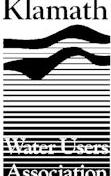
Klamath Water Users Association
Weekly Update
November 21, 2003
|
|
Klamath Water Users Association Weekly Update November 21, 2003
|
USFWS Attributes "Combination of Factors" for 2002 Klamath Fish Die-Off A long awaited report prepared by the U.S. Fish and Wildlife Service (USFWS) cites an "unusual combination of factors" that led to the deaths of over 34,000 salmon and other fish in the Klamath River in 2002. The report’s findings are generally consistent with those contained in a comprehensive report prepared by the National Research Council (NRC). However, critics of the Klamath Project quickly zeroed in on one of the factors identified by USFWS – low flows – and used the report’s release as an opportunity to turn up the heat on the federal government and Project irrigators. "It should be pretty bonehead obvious that fish need water to survive," Glen Spain of the Pacific Coast Federation of Fishermen’s Associations told the Los Angeles Times. "If you keep cutting the water year after year, you’ll eventually crash the system." Spain and other environmentalists hit the streets running Tuesday morning, when the USFWS publicly issued two reports on the fish die-off. By the end of the day, major urban newspapers up and down the West Coast carried their simple message – "fish need water". Many media accounts focused on the flow issue, despite the report’s identification of three other factors that, collectively, likely contributed to the 2002 die-off. Those factors included a high density of congregating fish in 2002, warm temperatures and a delayed upstream migration. The report does not list any one of the factors – including flows – as having any more or less significance than the others. It also does not contain any recommendations for increasing flows in either the Klamath River mainstem or the Trinity River, the largest tributary. "Basically, the Fish and Wildlife report confirms the NRC report," said Jeff McCracken, spokesman for the U.S. Bureau of Reclamation, to the San Francisco Chronicle. "It cites a multitude of factors, not an obvious single explanation, and I don’t see where it says we should increase flows down the Klamath." David Vogel, a fisheries biologist working for the Klamath Water Users Association, agrees, and believes low flows cannot be singled out as the sole reason for fish dying near the outlet of a 10.5 million acre river system. "There was a unusual sequence of events that acted together to cause it," he said. The USFWS study attributes the direct cause of death for most of the fish to an outbreak of two freshwater pathogens, Ich and columnaris. Both pathogens are commonly found in the Klamath River, so additional factors combined to stress the fish and increase their susceptibility to the pathogens. The report says those factors included:
Fish and Wildlife Service Director Steve Williams praised the scientists who prepared the report, which took more than a year to complete and was the subject of a rigorous internal peer review. "Our team of scientists conducted an exhaustive, multi-faceted study of this loss of Klamath River fish," Williams said. "Its findings, which are based on the best available scientific data, are consistent with those of the recent National Research Council report. Both reports conclude that the river’s troubles are due to a multitude of factors, and improving the river will require a watershed effort by Federal and State agencies, the Tribes, and other stakeholders." While there are similarities between the NRC report and the USFWS report, there are also key differences. The USFWS study suggests that 2002 featured a unique combination of low discharges – especially from Iron Gate Dam – and high run size. USFWS supports this conclusion based on the "positive response of fish movement at Ishi Pishi Falls when flows were increased from Iron Gate Dam" in late September 2002. Yet, the NRC report notes that the late September release of 500 cfs from Iron Gate Dam by USBR, which arrived long after the fish kill had ended, "lacked any specific justification". USFWS also concludes that large numbers of fish congregated in the lower Klamath River, in part due to "constant low flows that resulted in a lack of cues for upstream migration." The NRC report, on the other hand, concludes "it is unclear whether low flows actually blocked upstream migration, or as suggested by the literature, that most of the fish stopped moving due to the high temperature". The NRC study notes the California Department of Fish and Game cites evidence that at least a portion of the run was capable of moving upstream during these low-flow conditions.Most of the dead fish – about 97 percent – were fall-run Chinook salmon. About 2 percent were steelhead and 1 percent were coho salmon. The lost fall-run Chinooks represented about 19 percent of the total run of nearly 170,000 fish in the Klamath River and its largest tributary, the Trinity River. Both reports can be viewed or downloaded at the Sacramento Fish and Wildlife Office’s Web site at http://sacramento.fws.gov/ CALENDAR OF EVENTS Tuesday, December 2 – Friday, December 5, 2003. Oregon Water Resources Congress Annual Conference. Seaside, Oregon. Tuesday, December 2 – Friday, December 5, 2003. Association of California Water Agencies Conference. San Diego, California. |
|
Klamath Water Users
Association |
Content and Logo: Copyright © Klamath
Water Users Association, 2002 All Rights
Reserved
Page design: Copyright ©
klamathbasincrisis.org, 2002, All Rights
Reserved